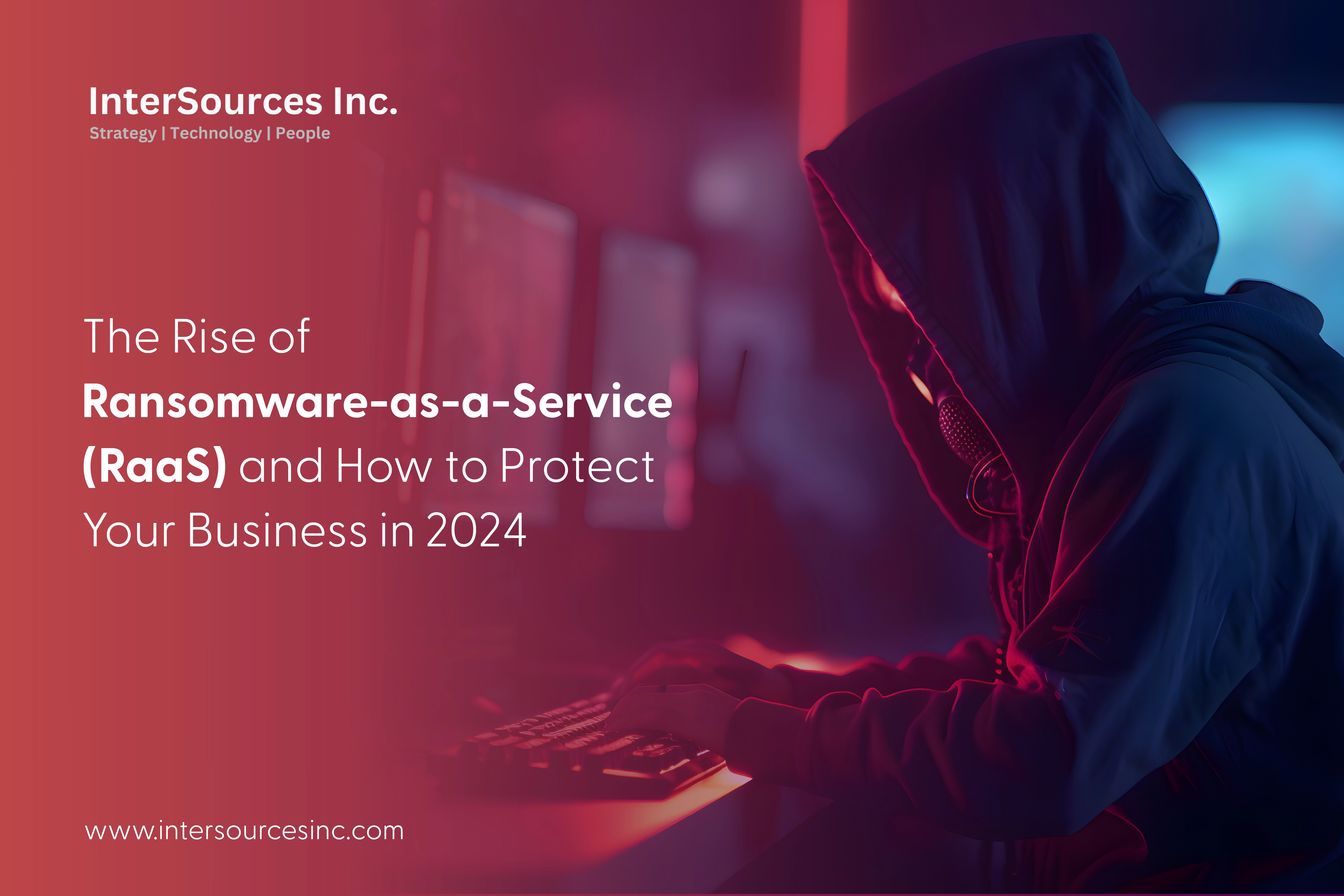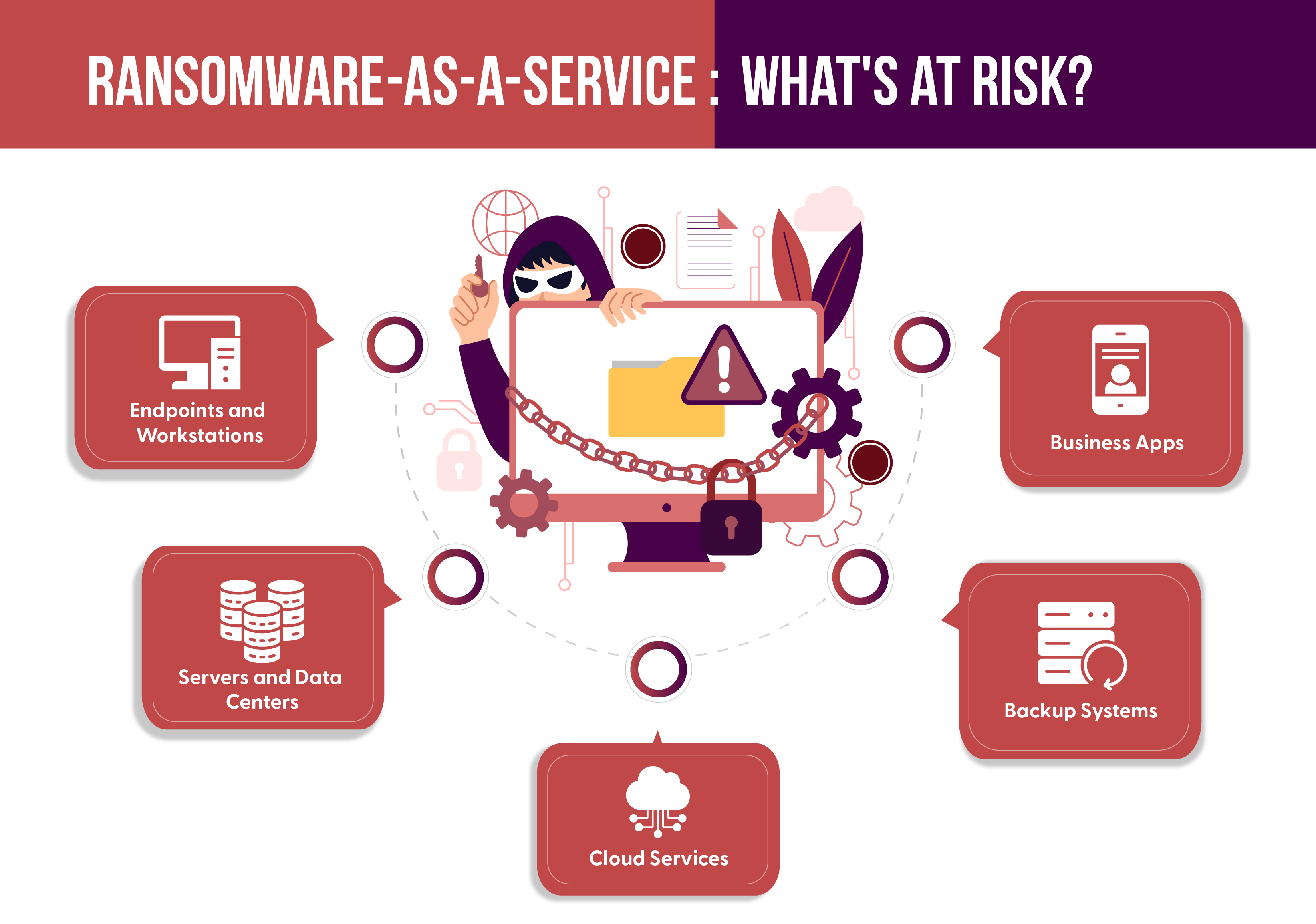← All Blogs

The Rise of Ransomware-as-a-Service (RaaS) and How to Protect Your Business in 2024
Gone are the days when ransomware was merely a sporadic threat. Today, it has evolved into a sophisticated and organized business model known as Ransomware-as-a-Service (RaaS).
So, what exactly is Ransomware-as-a-Service? It is a subscription-based offering from cybercriminals. Much like a legitimate software service, RaaS allows individuals, often with minimal technical skills, to rent or purchase sophisticated ransomware tools. These tools come with all the necessary infrastructure for launching and managing attacks, including delivery methods and payment systems for collecting ransoms.
Industry analysts predict a surge in RaaS attacks in 2024, making it easier than ever for even amateurs to unleash digital mayhem. We'll break down exactly what RaaS is, why it's so dangerous, and – most importantly – how you can fortify your business defenses in 2024.
Stay tuned, because in this blog, we'll equip you with the knowledge to fight back and keep your valuable data safe.
Understanding RaaS: How does Ransomware-as-a-Service work?
Think of RaaS as a dark web marketplace. Developers cook up the nasty code (ransomware) and offer it, along with helpful tips and tricks, to anyone willing to pay. These cyber-freelancers, called affiliates, then unleash the attack on businesses, hoping to score a hefty ransom.
The scary part? RaaS makes becoming a cybercriminal shockingly easy. No coding genius is required! This widens the pool of attackers, making it even more crucial to fortify your defenses.
And here's the kicker: RaaS keeps evolving. Today's offerings are far more sophisticated, with features like customizable ransomware and tools to bypass security software. It's a lucrative business, too, with developers and affiliates splitting the spoils.
Why RaaS Poses a Significant Risk to Businesses in 2024
Ransomware-as-a-Service 2024 poses a significant risk to businesses due to its accessibility and profitability. With a 62% increase in attacks, cybercriminals can now easily rent RaaS kits, targeting companies of all sizes. This trend is alarming as it lowers the entry barrier for attackers, leading to more frequent and sophisticated breaches.
Recent data shows that the average ransom payment surged to $812,000, up 33% from last year. Businesses must stay vigilant, invest in robust cybersecurity measures, and educate employees to counteract this growing threat. Protecting your business requires a proactive approach in this evolving cyber landscape.
What Kind of Business Technology are Risked from Raas?

RaaS is a booming cybercrime trend in 2024, making cyberattacks accessible to even rookie criminals. But what exactly is at risk?
Here's a closer look at the types of technology that are most at risk:
Endpoints and Workstations: Employees' devices are prime targets for RaaS attacks. These endpoints often serve as entry points, making it crucial to enforce stringent security measures and regular software updates. Recent statistics show that 72% of businesses experienced ransomware attacks targeting employee devices in the past year.
Servers and Data Centers: Servers holding critical data are highly susceptible to ransomware. A compromised server can lead to a catastrophic loss of sensitive information. In 2024, nearly 50% of data breaches involved server exploitation, highlighting the need for robust security protocols.
Cloud Services: The reliance on cloud services continues to grow, yet these platforms are not immune to RaaS. Public-facing and internal applications are at risk, potentially leading to significant business disruption. Industry trends indicate a 45% increase in cloud service attacks over the last year.
Business Apps: Operational applications used by employees are essential for day-to-day functions. An attack on these systems can paralyze organizational operations. A recent survey revealed that 62% of businesses reported disruptions in business applications due to ransomware.
Backup Systems: A compromised backup system can result in a total failure to restore services. Ensuring that backups are secure and regularly tested is vital. Data from 2023 shows that 37% of organizations were unable to restore their systems effectively after a ransomware attack.
Potential Valuation Losses for Companies: From Small to Large Enterprises
RaaS is not just a threat—it's a burgeoning industry making waves across all company sizes. The impact of these attacks on a company's valuation can be staggering and varies significantly between small and large businesses.
For small businesses, the stakes are incredibly high. Recent statistics reveal that ransomware attacks can cause a valuation dip ranging from 10% to 50%. Imagine a company valued at $1 million; a ransomware attack could reduce its worth by $100,000 to $500,000. This substantial financial loss isn't just a number—it can cripple a small business's ability to invest, grow, and even survive.
Large enterprises are not immune, though the percentage impact tends to be lower, ranging from 5% to 20%. For a corporation valued at $500 million, this translates into a potential loss of $25 million to $100 million. Such losses can impact stock prices, investor confidence, and long-term strategic planning.
The growing trend of RaaS attacks in 2024 underscores the urgent need for robust cybersecurity measures. Without them, companies—regardless of size—face not only immediate financial strain but long-term valuation repercussions that can alter their market standing for years to come.
Read Our Latest
AI and Automation: The Dynamic Duo for Cybersecurity ROI Enhancement
Best Practices to Defense Against RaaS Attacks
RaaS has become the go-to weapon for cyber thugs, thanks to its ease of use. But fear not, business owner! Here are the best practices on how to prevent ransomware-as-a-service attacks.
First up, patch management. Think of it as sealing cracks in your castle walls. By fixing known software vulnerabilities, you shut the door on these digital bandits.
Next, we compartmentalize! Network segmentation creates internal firewalls, limiting the spread of ransomware if it breaches the outer defenses.
Now, let's equip your soldiers (employees) with the latest weaponry. Robust endpoint security solutions act like digital shields, constantly scanning and deflecting threats. But remember, knowledge is power. Train your team on phishing scams and secure password habits – they'll be your first line of defense.
Finally, the ultimate safety net: backups. Regularly copy your data to a secure, offline location. Think of it as a hidden treasure trove, untouched by any ransomware siege. Remember to test your backups – a treasure map is useless if it leads to a dry well!
Beyond Prevention: Incident Response and Recovery
Even the most secure systems can be breached. That's why having a plan for when a ransomware attack hits is crucial. Here's the deal: a well-rehearsed incident response plan minimizes downtime, limits damage, and gets your business back on track.
Cyber insurance can also be a financial lifesaver, covering recovery costs and even ransom negotiations (in some cases). But it's not just about money.
Clear communication with employees, clients, and authorities throughout the ordeal is vital for maintaining trust and minimizing panic. Remember, preparation is power – so be prepared to fight back!
Conclusion
In 2024, Ransomware-as-a-Service (RaaS) is transforming from a niche threat into a widespread danger, targeting businesses of all sizes. With the stakes higher than ever, it’s crucial to stay ahead with robust cybersecurity measures. Don't wait until you're locked out of your own system—take proactive steps to protect your assets today. For tailored cybersecurity solutions that defend against RaaS and other threats, Contact InterSources Inc. now. Let’s secure your future together.
